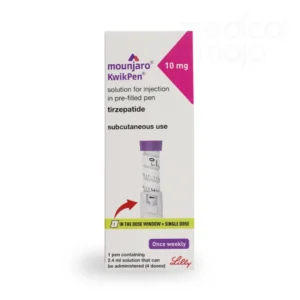Polycystic ovary syndrome (PCOS) is the most common hormonal condition affecting women of childbearing age. It disrupts the body’s metabolism, increasing the risk of serious health problems like type 2 diabetes, heart disease, and even endometrial cancer. Recent studies suggest that weight loss can significantly improve PCOS symptoms, which means that medicines that promote weight-loss could prove beneficial.
So, when discussing Mounjaro for PCOS, improvements in symptoms can occur due to its weight-loss abilities (up to 22.5% weight loss with Mounjaro 15mg) and its ability to regulate insulin.
Table of contents
- What is Mounjaro?
- Polycystic Ovary Syndrome (PCOS): An overview
- What is PCOS?
- Prevalence of PCOS
- What are the symptoms of PCOS?
- How is PCOS Diagnosed?
- PCOS and weight management
- Mounjaro and PCOS
- How effective is Mounjaro for weight loss?
- Insulin resistance in PCOS
- Mounjaro for insulin resistance in PCOS
- Conclusion – Mounjaro for PCOS
- Next steps: How to use Mounjaro for PCOS
- Frequently asked questions about Mounjaro
-
 Mounjaro 5mg Injection£145.99 – £565.99
Mounjaro 5mg Injection£145.99 – £565.99 -
 Mounjaro 10mg Injection£185.99 – £735.99
Mounjaro 10mg Injection£185.99 – £735.99 -
 Mounjaro 15mg Injection£229.99 – £899.99
Mounjaro 15mg Injection£229.99 – £899.99
What is Mounjaro?
Mounjaro is a prescription weight loss injection, containing the active ingredient tirzepatide. It is approved for the treatment of obesity and type 2 diabetes and is typically used alongside a healthy diet and regular exercise.
Mounjaro works by targeting two hormones: glucagon-like peptide 1 (GLP-1) and glucose-dependent insulinotropic polypeptide (GIP). These hormones are released from the digestive system when food is consumed and help to:
Early studies on diet-induced obese (DIO) mice demonstrated that combining GLP-1 and GIP resulted in significantly greater weight loss.
Polycystic Ovary Syndrome (PCOS): An overview
Polycystic ovary syndrome (PCOS) is the most common hormonal disorder that affects women of reproductive age. It is characterised by symptoms that can have significant physical, hormonal, and metabolic effects, such as:
PCOS can lead to infertility, metabolic disorders, and long-term health complications, including diabetes and cardiovascular disease.
Although the exact cause of PCOS remains unclear, genetics and environmental factors are believed to play a significant role in its development.
What is PCOS?
PCOS is a condition where a woman’s ovaries produce an abnormal amount of male hormones, known as androgens. This hormone imbalance interferes with the normal development and release of eggs (ovulation), which is crucial for conception.
The name “polycystic ovary syndrome” comes from the appearance of the ovaries in women with this condition. The ovaries may contain multiple small cysts (fluid-filled sacs), which are immature follicles that have failed to release eggs.
PCOS is one of the leading causes of infertility in women and is commonly linked with metabolic disturbances, such as insulin resistance.
Up to 70% of women with PCOS may have insulin resistance, which can lead to higher blood sugar levels and increase the risk of developing type 2 diabetes.
Prevalence of PCOS
PCOS is one of the most common endocrine disorders, affecting approximately 8% to 20% of women
Early diagnosis and treatment can improve quality of life and fertility outcomes.
What are the symptoms of PCOS?
PCOS manifests through a wide range of symptoms, which may vary in severity. Some of the most common symptoms include:
- Irregular periods: One of the hallmark features of PCOS is irregular menstruation. Women with PCOS may experience infrequent, absent, or heavy periods, often due to anovulation (lack of ovulation).
- Excess androgen levels: Women with PCOS often exhibit elevated levels of androgens, the male hormones. This can result in:
- Hirsutism: Excessive hair growth on the face, chest, or back.
- Alopecia: Thinning hair or male-pattern baldness.
- Acne: Persistent acne, especially on the face, chest, and back.
- Polycystic ovaries: As the name suggests, women with PCOS typically have enlarged ovaries containing multiple cysts. These cysts are actually follicles that have failed to mature and release an egg.
- Infertility: Due to anovulation (no ovulation), PCOS is one of the leading causes of infertility. Women with the condition may have difficulty conceiving because their ovaries do not release eggs regularly.
- Weight gain: Many women with PCOS experience weight gain, often around the abdominal area, which can worsen other symptoms like insulin resistance.
- Insulin resistance: Many women with PCOS develop insulin resistance, which can lead to higher levels of insulin in the blood. Over time, this can increase the risk of developing type 2 diabetes and other metabolic issues.
- Sleep apnoea: Obesity in women with PCOS can contribute to obstructive sleep apnoea, a condition where the airway becomes blocked during sleep, leading to breathing difficulties.
These symptoms often begin during adolescence, and while some women may experience only a few of them, others may face a combination of many.
How is PCOS Diagnosed?
The Rotterdam Criteria are commonly used to diagnose PCOS. According to this criterion, a diagnosis is made when two of the following three conditions are present:
- Irregular ovulation or anovulation
- Elevated androgen levels
- Polycystic ovaries visible on ultrasound
PCOS and weight management
Many women with polycystic ovary syndrome (PCOS) find it hard to lose weight. Studies show that between 38% and 88% of women with PCOS are either overweight or obese.
One major factor why women with PCOS find it hard to lose weight is insulin resistance, which can lead to the body storing more fat and making it harder to lose weight. Some studies also suggest that insulin resistance can make people feel hungrier.
Women with PCOS are also more likely to develop type 2 diabetes. In fact, they are eight times more likely to get it compared to women without PCOS who are the same age.
This increased risk shows just how important it is for women with PCOS to manage their weight, as keeping a healthy weight can help reduce the chances of getting type 2 diabetes and other health issues.
Mounjaro and PCOS
One way to manage the symptoms of PCOS is by maintaining a healthy weight. Even losing just 5% of your body weight can help regulate hormone levels and improve your menstrual cycle.
Research shows that weight loss can also reduce the risk of developing other health issues related to PCOS, such as metabolic conditions.
One treatment option for weight loss in people with PCOS is Mounjaro (tirzepatide), which mimics two natural hormones, GIP and GLP-1, that are released from the intestines.
These hormones help control blood sugar by slowing down the emptying of your stomach, increasing insulin production, and reducing the amount of food you feel like eating, helping you feel fuller for longer.
How effective is Mounjaro for weight loss?
Mounjaro, given as a weekly injection, has proven to be highly effective in clinical studies. In the SURMOUNT 1 trial , individuals with obesity (but without diabetes) who used the highest maintenance dose of 15mg experienced an average weight loss of 22.5% over 72 weeks.
Insulin resistance in PCOS
Up to 70% of women with PCOS may have insulin resistance. This means your body struggles to use insulin properly, making it difficult to process the sugar (glucose) in your blood. As a result, insulin resistance leads to higher blood sugar levels, which the body stores as fat, making weight loss harder.
For people with PCOS, insulin resistance is often managed through changes in lifestyle, like eating a healthy diet and getting regular exercise, with the goal of controlling weight.
Mounjaro for insulin resistance in PCOS
Metformin, a medication, is commonly prescribed alongside these lifestyle changes. It helps the body become more sensitive to insulin.
Mounjaro could be a potential alternative as it helps improve blood sugar levels and insulin resistance by boosting insulin production in the pancreas when blood sugar rises. This helps keep blood sugar levels stable.
Additionally, Mounjaro prevents the liver from releasing extra sugar (glucagon) into the bloodstream.
By stabilising your blood sugar levels, Mounjaro helps reduce cravings and makes it easier to maintain a healthy weight.
Conclusion – Mounjaro for PCOS
Polycystic ovary syndrome is a complex condition that affects many women of reproductive age. While there is no cure for PCOS, effective treatments are available to manage the symptoms and reduce the risk of long-term health complications.
A combination of lifestyle changes, medication, and, in some cases, fertility treatments can help women with PCOS achieve their health and reproductive goals.
Early diagnosis and appropriate management are key to improving quality of life and reducing the risk of associated conditions like type 2 diabetes and heart disease.
Mounjaro can play an important role in helping women with PCOS by:
- Promoting weight loss, and
- Reducing insulin resistance
More research needs to be done before Mounjaro is licensed to treat PCOS but the initial results are encouraging.
Contact us for more information about how Mounjaro can be used to help with PCOS.
Next steps: How to use Mounjaro for PCOS
Mounjaro is approved for treating adults with obesity, excess weight, or type 2 diabetes. For women with PCOS and obesity, losing at least 5% of body weight can greatly improve symptoms and reduce the risk of long-term health issues.
Mounjaro could help women with PCOS manage their symptoms and improve overall health. If you’re interested in trying Mounjaro for PCOS, speak with your doctor or pharmacist.
Medical Mojo offers a free online consultation to help you find the best weight loss treatment for your needs. If Mounjaro is right for you, the you just select how many you require and make payment. We then will ensure FREE safe and discreet delivery to your UK address.
Are weight loss treatments making you tired, or have they led to a sudden increase in hair loss? Do you struggle with sleep?
Get a free month’s supply of one of our compounded treatments for energy, hair loss or sleep, with your first purchase of Mounjaro or Wegovy from Medical Mojo.
Claim your FREE offer
Frequently asked questions about Mounjaro
Can I drink alcohol while using Mounjaro?
It’s advised to reduce alcohol intake while using Mounjaro, as alcohol can increase the likelihood of side effects such as nausea or dizziness. For more information about Mounjaro and alcohol, please check out our blog, “Can you drink alcohol while taking Mounjaro?”
Does Mounjaro cause thyroid cancer?
Although there were initial concerns, since rodents developed thyroid cancer in the pre-clinical trials with rodents, there is very little evidence to suggest that Mounjaro causes thyroid cancer. To learn more, read our blog, “Does Mounjaro cause thyroid cancer?”
Does Mounjaro cause hair loss?
Hair loss occurs in about 5% of individuals taking Mounjaro, however, whether this is due to the effects of Mounjaro itself or the effects of rapid weight loss is not fully understood. To learn more, read our blog, “Does Mounjaro cause hair loss?”
How long do the side effects of Mounjaro last?
When you begin taking Mounjaro, you might experience side effects like nausea, bloating, and constipation. To help your body adjust, Mounjaro uses a gradual dose escalation process. These side effects typically lessen within a few days or weeks as your body becomes more familiar with the medication. For more information, read our blog, “How long do the side effects of Mounjaro last?”
Can I start Mounjaro at 5 mg?
No, the starting dose of Mounjaro is 2.5 mg. Following the recommended dosing schedule is important to minimise side effects and help your body adjust to the medication safely.
Is Mounjaro 15mg the only maintenance dose?
No, there are three maintenance doses for Mounjaro:
To learn more about the maintenance doses of Mounjaro, read our blog, “Mounjaro maintenance doses”.
Disclaimer: This article is for informational purposes only and is not a substitute for professional medical advice.
References:
- Agrawal, A VI., Dave, A. and Jaiswal, A. (2023) Type 2 Diabetes Mellitus in Patients With Polycystic Ovary Syndrome. Cureus. 15(10).
- Anala, A. D., Saifudeen, I. S.H., Ibrahim, M., et al. (2023) The Potential Utility of Tirzapatide for the Management of Polycystic Ovary Syndrome. Journal of Clinical Medicine 12(14).
- Azziz, R., Woods, K.S., Reyna, R., Key, T.J., Knochenhauer, E.S. and Yildiz, B.O., 2004. The prevalence and features of the polycystic ovary syndrome in an unselected population. The Journal of Clinical Endocrinology & Metabolism, 89(6), pp.2745-2749.
- Azziz, R., et al. (2004). “The Polycystic Ovary Syndrome: A Review of Current Concepts.” Fertility and Sterility, 81(1), 8-23.
- Bani Mohammad, M. & Majdi, S. A. Polycystic ovary syndrome (PCOS), diagnostic criteria, and AMH. Asian Pac. J. Cancer Prev. 18(1), 17–21 (2017).
- Barber, T.M. and Franks, S., 2021. Obesity and polycystic ovary syndrome. Clinical endocrinology, 95(4), pp.531-541.
- Barber TM. Why are women with polycystic ovary syndrome obese? Br Med Bull. 2022 Sep 22;143(1):4-15.
- Begum, S., Hossain, M.Z., Rahman, M.F. and Banu, L.A., 2012. Polycystic ovarian syndrome in women with acne. Journal of Pakistan Association of Dermatologists, 22(1), pp.24-29.
- Chavda VP, Ajabiya J, Teli D, Bojarska J, Apostolopoulos V. Tirzepatide, a New Era of Dual-Targeted Treatment for Diabetes and Obesity: A Mini-Review. Molecules. 2022 Jul 5;27(13):4315.
- Coskun, T., Sloop, K.W., Loghin, C., Alsina-Fernandez, J., Urva, S., Bokvist, K.B., Cui, X., Briere, D.A., Cabrera, O., Roell, W.C. and Kuchibhotla, U., 2018. LY3298176, a novel dual GIP and GLP-1 receptor agonist for the treatment of type 2 diabetes mellitus: from discovery to clinical proof of concept. Molecular metabolism, 18, pp.3-14.
- Deshpande, P.S. and Gupta, A.S., 2019. Causes and prevalence of factors causing infertility in a public health facility. Journal of human reproductive sciences, 12(4), pp.287-293.
- Han, Y., Li, Y. and He, B., 2019. GLP-1 receptor agonists versus metformin in PCOS: a systematic review and meta-analysis. Reproductive biomedicine online, 39(2), pp.332-342.
- Jastreboff, A.M., Aronne, L.J., Ahmad, N.N., Wharton, S., Connery, L., Alves, B., Kiyosue, A., Zhang, S., Liu, B., Bunck, M.C. and Stefanski, A., 2022. Tirzepatide once weekly for the treatment of obesity. New England Journal of Medicine, 387(3), pp.205-216.
- Kahal, H., Kyrou, I., Tahrani, A.A. and Randeva, H.S., 2017. Obstructive sleep apnoea and polycystic ovary syndrome: a comprehensive review of clinical interactions and underlying pathophysiology. Clinical endocrinology, 87(4), pp.313-319.
- Marshall, J. C., Dunaif, A. (2012) Should all women with PCOS be treated for insulin resistance? Fertility and sterility 97(1)P:18-22.
- https://www.nhs.uk/conditions/polycystic-ovary-syndrome-pcos/treatment/
- Rotterdam ESHRE/ASRM?Sponsored PCOS Consensus Workshop Group, 2004. Revised 2003 consensus on diagnostic criteria and long?term health risks related to polycystic ovary syndrome (PCOS). Human reproduction, 19(1), pp.41-47.
- Ovalle, F. and Azziz, R., 2002. Insulin resistance, polycystic ovary syndrome, and type 2 diabetes mellitus. Fertility and sterility, 77(6), pp.1095-1105.
- Polycystic ovary syndrome. NHS. Retrieved 20 June 2024. Accessible here.
- Rodin, J. (1985) Insulin levels, hunger and food intake: an example of feedback loops in body weight regulation. Health Psychology: official journal of the Division of Health Psychology 4(1)P1-24.
- Tehrani, F. R., et al. (2011). “The prevalence of polycystic ovary syndrome in a population-based sample.” Journal of Clinical Endocrinology & Metabolism, 96(6), 1525-1531.
- Rotterdam ESHRE/ASRM-Sponsored PCOS Consensus Workshop Group. (2004). “Revised 2003 consensus on diagnostic criteria and long-term health risks related to polycystic ovary syndrome (PCOS).” Human Reproduction, 19(1), 41-47.
- Seino Y, Fukushima M, Yabe D. GIP and GLP-1, the two incretin hormones: Similarities and differences. J Diabetes Investig. 2010 Apr 22;1(1-2):8-23.
- Sinha R, Papamargaritis D, Sargeant JA, Davies MJ. Efficacy and Safety of Tirzepatide in Type 2 Diabetes and Obesity Management. J Obes Metab Syndr. 2023 Mar 30;32(1):25-45. doi: 10.7570/jomes22067. Epub 2023 Feb 8. PMID: 36750526; PMCID: PMC10088547.
- Singh S., Pal N., Shubham S., Sarma D.K., Verma V., Marotta F., Kumar M. Polycystic Ovary Syndrome: Etiology, Current Management, and Future Therapeutics. J. Clin. Med. 2023;12:1454.
- Spritzer, P. M., Marchesan, L. B., Santos, B. R., & Fighera, T. M. (2022). Hirsutism, Normal Androgens and Diagnosis of PCOS. Diagnostics, 12(8), 1922. https://doi.org/10.3390/diagnostics12081922
- Tehrani, F. R., et al. (2011). “The prevalence of polycystic ovary syndrome in a population-based sample.” Journal of Clinical Endocrinology & Metabolism, 96(6), 1525-1531.
- Yang, L., Liang, F., Yuan, Y., Luo, X., Wang, Q., Yao, L. and Zhang, X., 2023. Efficacy of progestin-primed ovarian stimulation in women with polycystic ovary syndrome undergoing in vitro fertilization: a systematic review and meta-analysis. Frontiers in Endocrinology, 14, p.1224858.
- Zeng, X., Xie, Y.J., Liu, Y.T., Long, S.L. and Mo, Z.C., 2020. Polycystic ovarian syndrome: Correlation between hyperandrogenism, insulin resistance and obesity. Clinica chimica acta, 502, pp.214-221.
- Zuchelo, L.T., Alves, M.S., Baracat, E.C., Sorpreso, I.C. and Soares Jr, J.M., 2024. Menstrual pattern in polycystic ovary syndrome and hypothalamic-pituitary-ovarian axis immaturity in adolescents: a systematic review and meta-analysis. Gynecological Endocrinology, 40(1), p.2360077.


